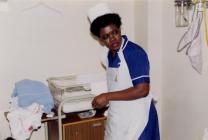Mrs Vernester Cyril OBE
Items in this story:
Early life in St Lucia
Vernester enjoyed a happy childhood surrounded by six siblings and loving parents who were determined their only daughter should have a good education.
As a child, Vernester would gaze at the ships going in and out of St Lucia harbour and wonder where they were going.
Attending the same Church of England school as Nobel Prize winner Derek Walcott, the young Vernester learned about England, saluted the Union Jack after prayer every morning and excelled at English literature studies which included Shakespeare and Kipling and poetry recital.
She may not have realised it at the time, but she was already sowing the seeds of a future life in the UK.
Coming to the UK
Vernester followed her husband Peter – a printer – to the UK in 1962.
Leaving her 'cushioned life' in Castries behind, she waved goodbye to her family and friends and set out in search of her new life across the Atlantic Ocean. Vernester travelled by ship, as many Caribbean people did, and spent ten days at sea, docking in the Mediterranean and travelling across Europe by land. Her caring nature came to the fore when she found herself in charge of two young children - a brother and sister - for the entire journey.
The first shock when she arrived in Paddington station was the weather. Always interested in fashion, Vernester had underestimated the chill factor of the British weather in March and was left shivering in her thin cotton dresses.
There were other things to get used to: the lines of chimneys with smoke coming out, department stores, groceries delivered by bicycle and gaps between paving stones where her heels got stuck.
The shops may have dazzled the young Vernester but finding an office job with a black face proved to be harder than she thought, even for a woman bright and determined as her. After a brief spell in a factory, she eventually she settled for work at a nursing home while she waited to start her nursing training.
A career in nursing and midwifery
St Lucia was still under colonial government in the early 1960s and the would-be nurse was aware the nurse training in the 'mother country' was considered the best in the world.
Vernester trained first as a nurse at the Royal Gwent and St Woolos Hospitals in Newport and then as a midwife. She passed her exams in 1973 with flying colours and was awarded the Best Promising Midwife award.
She worked at Lydia Beynon Maternity Hospital [now part of the Celtic Manor Resort] for three years, before returning to the Royal Gwent where she remained for the next thirty years. During that time, she delivered and assisted at the births of well over 500 babies.
Vernester worked tirelessly and was promoted to senior midwife manager.
Her long career ended on a high when she was nominated for - and won – the title of British Journal of Midwifery, Midwife of the Year in 2006. Never in Vernester's wildest dreams had she imagined being bestowed with such an accolade for a job she loved and was paid to do.
Challenging racism and promoting equality
Vernester expected to be welcomed to the UK with open arms, so was disappointed when the reality turned out to be somewhat different.
Resilient by nature, she refused to let the racism she encountered get her down, bouncing back after each incident. And if people stared and made funny faces, then that was their problem.
She was resolute in her determination to educate herself - and others - in the history and cultural traditions of black people. When a nursing sister reprimanded her for wearing her hair in a natural Afro hairstyle, Vernester told her to look at books and see how people wore their hair in the Caribbean and Africa.
There was racism from patients too, but Vernester persisted in her studies and recharged her batteries in the far more cosmopolitan London whenever she had the opportunity. By now, Peter was working on the railways and train journeys to the capital's fresh food markets, where the familiar fruits of the Caribbean were on display, became frequent.
Race equality legislation did not yet exist; however, the liberal-thinking Vernester seized every opportunity to challenge discrimination and promote racial equality, standing up for those who were unable to speak for themselves.
She was the founding member of South East Wales Regional Equality Council and chair of trustees. Vernester has spoken about equalities issues at conferences across Wales. In 1998, she met her long-time hero, South African president Nelson Mandela when he was given the Freedom of the City of Cardiff.
Vernester’s services to the community were recognised in 1999 when she was awarded an OBE for community relations in South East Wales and went to Buckingham Palace to receive her award from the Queen. The little girl who once watched ships sailing out of the harbour and wondered what lay across the ocean had come a long way.






